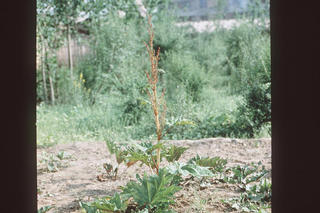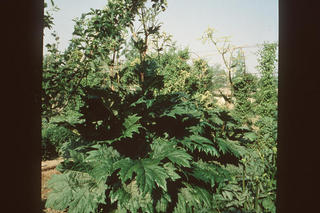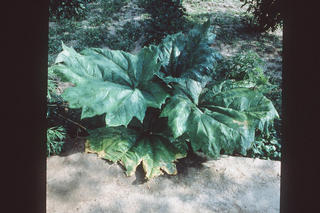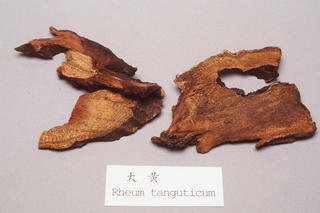Rheum tanguticum
Contents
Nomenclature
Other Names:
Historical Use of Rheum tanguticum
Rheum tanguticum in Traditional Chinese Medicine
Background
Dahuangtan ´ó»ÆÌ¿
Jiudahuang ¾Æ´ó»Æ
Shengdahuang Éú´ó»Æ
Shudahuang Êì´ó»Æ
Chinese Name (pinyin): Dahuang
Chinese Name :
Common Name :Rhubarb
Specific Name : Radix et rhizoma rhei
Scientific Name:
Collection : The drug is collected in late autumn when stem and leaves are withered or in next spring just before budding, removed from rootlet and the outer bark, cut into segment or section either stringed together to be dried or dried directly.
Description : In subcylindrical, conical ovoid or irregular shaped pieces. 3 - 17 cm long, 3 - 10 cm in diameter. Externally yellowish brown to reddish brown when peeled. Sometimes when whitish reticulations and scattered star spots (abnormally vascular bundles) visible, occasionally with brownish black, patches of cork, mostly with a hole through which the string passed and coarse wrinkles. Texture compact, sometimes rather loose and soft in the center, fracture reddish brown or yellowish brown, granular. Pith of the rhizome broad with a star spots arranged in a ring or irregularly scattered. Wood of the root well developed, lined radially, cambium ring distinct without star spots. Odour delicately aromatic, taste bitter and slightly astringent, sticky and gritty on chewing.
Identification : 1.Transverse section: Most cork and cortex of fruit removed. In phloem, sieve tube groups distinct, parenchyma well developed, cambium in a ring, xylem with relatively dense rays. 2 - 4 cells wide. Containing brown masses, vessels unlignified, usually single or several grouped, sparsely arranged. Parenchymatous cells containing clusters of calcium oxalate and abundant starch granules. Pith of rhizome broad, usually showing mucilage cavities, containing reddish brown masses, abnormal vascular bundles scattered, cambium in a ring, xylem at the outside and phloem at the inside. Rays stellately radiated.Powder: Yellowish brown, clusters of calcium oxalate. 20 - 160 µm in diameter. Bordered pitted, reticulate, spiral and annular vessels unlignified. Starch granules fairly abundant, single granules subspheroidal or polygonal. 3 - 45 µm in diameter, hilum stellate, compound consisting of 2 - 8 components.2.Sublime a small quantity of the powder, rhombic needles or featherly crystals are visible.3.Macerate to 0.1g of the powder in 2o ml of methanol for 1 hour and filter. Evaporate 5 ml of the filtrate to dryness, dissolve the residue in 10 ml of water, add 1 ml of hydrochloric acid, heat on a water bath for 30 minutes and cool immediately. Extract with 2 quantities each of 20 ml of ether. Combine the ether extracts, evaporate to dryness and dissolve the residue in 1 ml of chloroform as the test solution. Prepare a solution of Radix et Rhizoma Rhei reference drug in the same manner as the drug solution. Dissolve rhein CRS in methanol to produce a solution containing 1 mg per ml as the reference solution. Carry out the method for thin layer chromatography (Appendix Vl B) using silica gel H containing sodium boxymethylcellulose as the coating substance and petroleum ether (30 - 60ºC)-ethyl formate-formic acid (15:5:1) as the mobile phase. Apply separately to the plate 4 µl of each of the three solutions. After developing and removal of the plate, dry it in the air and examine under ultra violet light (365 nm). The five orange fluorescent spots in the chromatogram obtained with the test solution correspond in position and colour to the spots in the chromatogram obtained with the reference drug solution. The orange fluorescent spot in the chromatogram obtained with the test solution correspond in position and colour to the spot in the chromatogram obtained with the reference solution. The spot becomes red under sunlight on exposure to ammonia vapor.Rhaponticin: Macerate warmly 0.2 g of the powder in 2 ml of methanol for 10 minutes and cool. Apply 10 µl of the supernatant to a piece of filter paper and develop using 45% ethanol as the mobile phase. After developing and removal of the paper, dry it in the air and allow to stand for 10 minutes. Examine under ultra violet light (365 nm), a persistent bright violet fluorescence is not shown.Loss on drying: When dried at 105ºC for 6 hours, loses not more than 15.0% of its weight (Appendix lX G).Total ash: Not more than 10.0% (Appendix lX K)Acid insoluble ash: Not more than 0.8%
Processing : Eliminate foreign matter, wash clean, soften thoroughly, cut into thick slices or pieces and dry it in the air.Stir fried with wine: Stir fry the slices as described under the method for stir frying with wine (Appendix ll D) to dryness.Prepared: Stew or steamed the pieces as described under the method for stewing or steaming with wine (Appendix ll D) until the drug darkens thoroughly.Carbonized: Stir fry the slices as described under the method for carbonizing by stir frying (Appendix ll D) until the outer surface charred and the inner surface turns to dark brown.
Action : To cause catharsis and purge away heat, to reduce heat in blood and counteract toxicity, and to eliminate blood stasis and stimulate menstrual discahrge. Radix et Rhizoma Rhei (stir-fried with wine): To remove toxic heat from the blood in th eupper portio
Indication :
Precautions : Used with caution in pregnancy.
Dosage : 3 to 30 g; not to be decocted for a long time if it is used for catharsis; for external use, appropriate quantity to be ground into powder for topical application after mixing with liquid.
Storage : Preserve in a ventilated and dry place, protected from moth.
Synonymns for Rheum tanguticum
Patent Medicines and Medicines with Multiple Ingredients that include Rheum tanguticum
Pharmaceutical Information
Chemical Constituents
Evidence or the Use of Rheum tanguticum in the Treatment of Epilepesy
Basic Science
Animal Studies
Cohort, Case-Control and Non-Randomized Trials
Randomized Controlled Trials
Meta-Analysis
1st Five Results: pubmed search
Praveena Chiowchanwisawakit, Annop Orawongpaisarn, Wanruchada Katchamart
Construct validity, reliability, and threshold value for treatment goals of the Thai version of the 12-item Psoriatic Arthritis Impact of Disease Questionnaire for patients with psoriatic arthritis.
Int J Rheum Dis: 2024, 27(4);e15139
[PubMed:38610096]
[WorldCat.org]
[DOI]
(I p)
Dionysis Nikolopoulos, Catherine Loukogiannaki, George Sentis, Panagiotis Garantziotis, Theodora Manolakou, Noemin Kapsala, Myrto Nikoloudaki, Antigone Pieta, Sofia Flouda, Ioannis Parodis, George Bertsias, Antonis Fanouriakis, Anastasia Filia, Dimitrios T Boumpas
Disentangling the riddle of systemic lupus erythematosus with antiphospholipid syndrome: blood transcriptome analysis reveals a less-pronounced IFN-signature and distinct molecular profiles in venous versus arterial events.
Ann Rheum Dis: 2024;
[PubMed:38609158]
[WorldCat.org]
[DOI]
(I a)
Scott E Wenderfer, Jennifer C Cooper
Do we really need cyclophosphamide for lupus nephritis?
Pediatr Nephrol: 2024;
[PubMed:38607424]
[WorldCat.org]
[DOI]
(I a)
Rashmi Dhital, Neha Chiruvolu Singh, Andrea M Spiker, Dilli Ram Poudel, Brian Pedersen, Christie M Bartels
Trends in avascular necrosis and related arthroplasties in hospitalized patients with systemic lupus erythematosus and rheumatoid arthritis.
Semin Arthritis Rheum: 2024, 66;152444
[PubMed:38604118]
[WorldCat.org]
[DOI]
(I a)
Tianyi Zhang, Lipan Zhou, Yang Pu, Yadi Tang, Jie Liu, Li Yang, Tao Zhou, Li Feng, Xumei Wang
A chromosome-level genome reveals genome evolution and molecular basis of anthraquinone biosynthesis in Rheum palmatum.
BMC Plant Biol: 2024, 24(1);261
[PubMed:38594606]
[WorldCat.org]
[DOI]
(I e)



